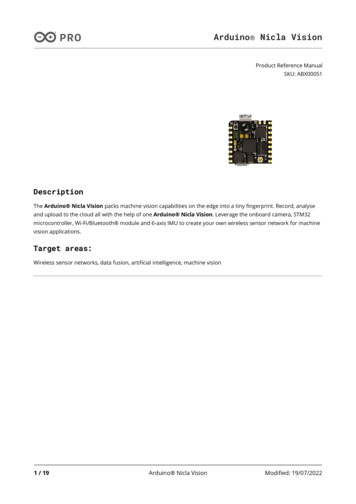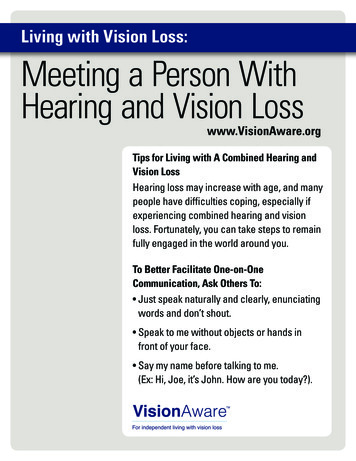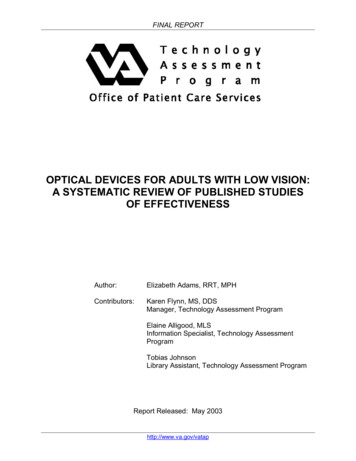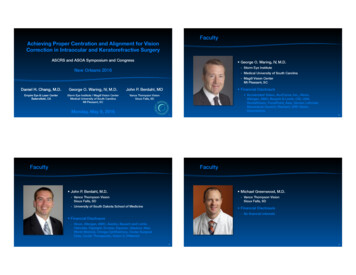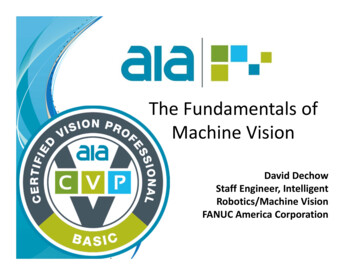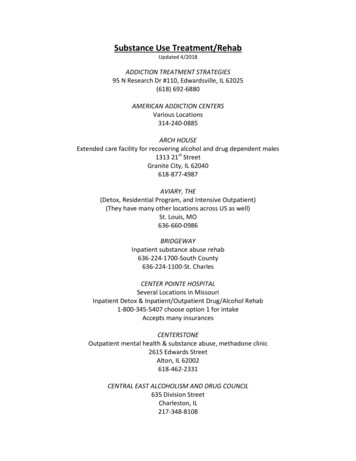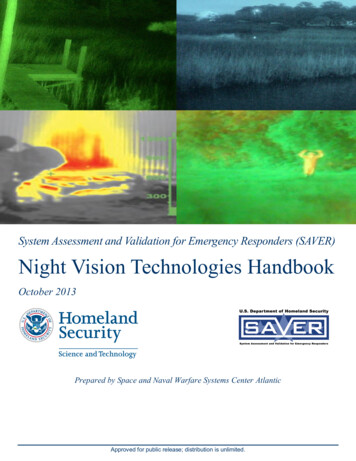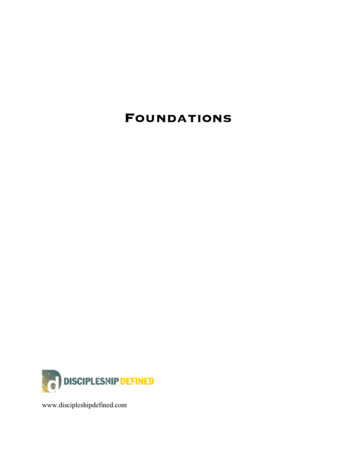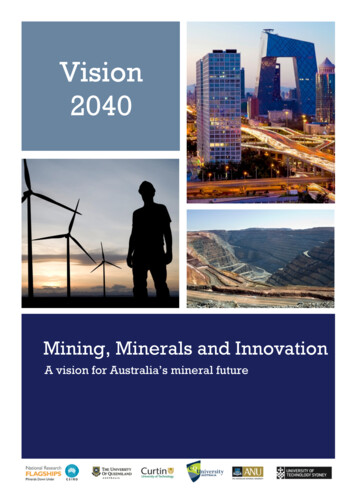
Transcription
Vision2040Mining, Minerals and InnovationA vision for Australia’s mineral future
About the Mineral Futures Collaboration ClusterThis publication has been produced as part of the research funded by the Mineral FuturesCollaboration Cluster. Researchers from the CSIRO Minerals Down Under Flagship and fiveAustralian universities have formed the Mineral Futures Collaboration Cluster (2009-2012) toaddress future sustainability issues facing the minerals industry in this country. One of the Cluster’sstrategic goals is focused on delivering national benefit and ongoing licence to operate for theminerals industry in Australia through research into 'Commodity Futures', 'Technology Futures' and'Regions in Transition'.More information about the Mineral Futures Collaboration Cluster can be found s-collaboration-cluster.htmlAbout the authorsLeading the work on ‘Commodity Futures’ is the Institute for Sustainable Futures (ISF) at theUniversity of Technology, Sydney. ISF was established in 1996, to develop sustainable futuresthrough research and consultancy work with industry, government and the community. Our missionis to create change toward sustainable futures that protect and enhance the environment, humanwellbeing, and social equity. We seek to adopt an inter-disciplinary approach to our work, andengage collaborators in processes that emphasise strategic decision-making for long-term benefit.Contact details can be found on page 28. Additional information is available at:http://www.isf.uts.edu.au and http://resourcefutures.net.auPlease cite this document as:Mason, L., Lederwasch, A., Daly, J., Prior, T., Buckley, A., Hoath, A., Giurco, D. (2011).Vision 2040: Mining, minerals and innovation – A vision for Australia’s mineral future, [prepared forCSIRO Minerals Down Under Flagship], Institute for Sustainable Futures (UTS, Sydney, Australia)and Curtin University (Perth, Australia).2
The path to Vision 2040BackgroundVision 2040 is the product of continuing research, and a series of stakeholder engagementprocesses outlined below.National Peak Minerals Forum (29 April 2010 - Sydney) Identified four key areas for positioning the minerals industry within a more sustainableAustralian economy: (1) technological advances, (2) new structures for long-term decisionmaking, (3) new approaches to business (not a ‘quarry’ but a ‘mineral services hub’), and (4)better distribution of impacts and benefits. Proposed actions: incentives for industry sustainability including research into mine siteremediation and new technology; new business models around resource custodianship.WEF Mining & Metals Scenarios (28 Sept 2010 - Melbourne) Participants explored Australian implications of megatrends under three scenarios preparedby the World Economic Forum (WEF): Green Trade Alliance; Rebased Globalism; ResourceSecurity. Proposed actions: development of a National Minerals Strategy and a sustainability ratingsystem for mining operations.Vision 2040 Workshop (28 November 2010 - Brisbane) At the 'Vision 2040: Innovation in Mining and Minerals' workshop, stakeholders analysedplausible future scenarios from which inputs to a preferred vision for Australia’s mining andminerals future were generated. Key themes: Net positive benefits; indigenous leadership; commodity chain value; BrandAustralia clean energy solutions; governance and reporting for long term benefit.Draft Vision 2040 & Consultation (May - June 2011) A consultation paper containing the draft Vision was used as the basis for stakeholderengagement. A national online feedback process, open to industry, government and thecommunity, was supplemented with key informant interviews. Feedback from this process hasbeen included throughout this document, and a summary of key feedback on the draft visionhas been included on page 25.Vision 2040 Launch (30 June 2011 - Perth) Building on two years of research and input from over 150 organisations and individuals,Vision 2040 aims to raise the profile of a national conversation about long term benefit,mining, minerals and sustainability. The intention of this document is to stimulate innovativethinking and analysis directed towards a national minerals strategy. Further research,including policy and technology options that will assist in making the vision a reality, will becompleted in 2011 and 2012.3
12 IntroductionAustralia’s mineral future in 2040It is 2040 and Australia's economic prosperity isinto the future. Concerns, issues, and ideasraised during this process have beenhighlighted to broaden the discussion andenrich a national conversation aboutAustralia’s mineral future.the result of decades old strategic decisionsabout the future. These decisions challengedthe short-termism of government policy andindustry focus on capitalising on highcommodity prices. These decisions made itpossible to harness Australian ingenuity fortransformational change. These decisions weremade by individuals and companies,communities and elected representatives inparliaments. These decisions about the futureshaped our present.Summary of key themes:Building long-term benefit for AustraliaProblem: Economic, social and environmentalimpacts are affecting the productivity ofmining in Australia, and future benefits.Solutions: Sovereign wealth fund to supportdiversification, infrastructure and innovation.Looking ahead to get aheadProblem: Declining mineral deposits arecreating greater impacts during operationsand upon closure.In 2011, the issues surrounding Australia’smineral future are complex, requiring broadand ongoing discussion among all stakeholdersto reframe problems, find solutions andidentify the opportunities that change willbring.Solutions: Embedding best practice mineclosure, and post-mining transitions, inplanning and daily operations. Exporting thisknowledge globally.Brand Australia: responsible mineralsProblem: Social licence to operate is extendingto sustainable and ethical supply chains forconsumer products and infrastructure.Vision 2040: Mining, Minerals and Innovationaims to provide direction for a national strategythat transforms existing assumptions about howAustralia can contribute to local and globaldevelopment.The consultation process for this visionaimed to answer the following questions: Solutions: Developing and applying accreditedstandards for mining operations; Link miningto clean energy.A National Mining StrategyProblem: Limited information and coordinationreduces strategic competitiveness andopportunities for innovation.What should Australians be doing with ourmineral endowment in the next 30 years tounderpin long-term national benefit?What strategies can deliver on a vision of aminerals industry embedded within asustainable Australian community in arange of future scenarios?What technologies and innovations shouldbe given priority for research anddevelopment?Solutions: Measuring and managing aboveand below-ground stocks to guide technologyand policy development.More detail on these problems and solutions isprovided in this document. Further informationabout ongoing research can be found on page25 and project contacts are provided on page28.Stakeholder views: Key stakeholders wereasked about their views of the benefits, costsand impacts of existing mineral industries andAustralia's role as a major supplier of minerals4
12 Mining and Minerals in 2040:Trends and driversMaturing demandIndigenous leadershipAustralian minerals production is projected torise, based on demand from countriesincluding China and India continuing to followgrowth trends. However, per capita steelconsumption in China is now maturing tosteadier levels, similar to those in developedeconomies like the USA (worldsteel 2010).It is expected that by 2040, indigenousAustralians will have increased their levels ofeconomic and political power with respect tomining and mineral production (Pearce, 2010).How will greater indigenous leadership in 2040affect mining and benefit sharing?Challenges for energy and waterLocal social and environmental impacts arealready a problem for securing andmaintaining social licence. As expectations for‘ethical’ products rise, manufacturers arelooking much further up the supply chain, toensure that all raw materials included in theirproducts comply. Could addressing localimpacts give “Brand Australia” the edge in thismarket?Social Licence to OperateEnergy consumption for mining in Australiahas increased by a factor of 10 over the lastdecade (ABARE 2009). In the future, Australia'scompetitiveness will depend on being able toaccess even more energy with dramaticallyreduced carbon dioxide emissions. Recentfloods and droughts have also demonstratedthat managing water is becoming a highpriority for both mining operations andsurrounding communities.New approaches for new needsRates of discovery for new, accessible, highgrade ores are declining. Consequently,research for new discoveries, technologies andapproaches are needed to continue Australia'sposition as a global commodity supplier and todevelop innovation beyond mining.International joint ventures, and strategiccollaborations between mining and otherindustry, universities, and government arerequired create long-term prosperity forAustralia.Excellence in remediationWith over 30,000 legacy sites in need ofremediation (Worrall 2009), the mineralsindustry in Australia must be at the forefront ofbest practice in mine closure and remediation.This will ensure that mining and mineralproduction is a ‘welcome guest’ rather than a‘bad tenant’ in communities.Planning for transitionsSimilarly, increasing emphasis on ‘Fly-In-FlyOut’ (FIFO) and ‘Drive-In-Drive-Out’ (DIDO)operations has reduced the benefits to localcommunities during operations, and failed toaddress collapses in economic developmentpost-closure. In 2040 Australia must lead theway in transition planning for communities.Making our own luckAustralia – the lucky country – must deepen itscommitment to innovative thinking andcollaborative action to build long-term valuefrom our resourcefulness – not just ourresources.5
Changing the storyOperationalising sustainability:new contexts, new understandingsUnderstandings of the world are changingThe idea of sustainable development came to the world’s attention through the Brundtlandreport “Our common future”(1987). The definition of sustainability used in the Brundtland reportstates that the development of the present should not deny future generations similaropportunities for development.Although it was once common to think of the human world of ‘society’ and ‘economics’ asseparate from the physical world, it is increasingly clear that the physical world sets limits onwhat human societies can achieve. With this change in our understanding of the world, ourunderstanding of ‘sustainability’ must also be revised.Figures 1 and 2 (below) illustrate the evolution of both our understandings of the world, and ofsustainable development. The key difference in these concepts is the relationship of the threeaspects of environment, society and economy.Figure 1 shows a common notion of sustainability, which underlies the “triple bottom line”approach to decision making (Elkington 1998). This view of interaction between three separatespheres, implies that each is independent of the others, and that ‘sustainability’ lies in the areathat overlaps. Figure 2 (adapted from Lowe 2010), shows our society and economy as being builtupon, or embedded within, our environment – the true ‘bottom line’ of sustainability. This notionsupersedes the concept of sustainability in figure 1, and recognises that both our economy, andour society, degrades as our natural environment is myEconomyFigure 1:Interlinking spheres notion of sustainabilityFigure 2:Nested or embedded notion of sustainabilityPractical decision-making applications ofthis view, have attempted to ‘balance’ ormake ‘trade-offs’ with what appear to becompeting interests.Practical decision-making applications of thisview recognize that a functional ecosystemprovides food and materials for shelter,allowing societies to develop the stabilityand trust that supports an economy.6
Making commitments to future generations:stakeholder viewsSetting objectives for social benefit“ current approach is ad-hoc and benefits are not comprehensively understood or appreciated.”Monitoring and evaluating the benefits of mining and mineral production are the foundation forimplementing systems of accountability for minerals. Stakeholders noted the importance ofdeveloping, or adapting, and implementing new measures of wealth and development that gobeyond GDP – measures that reflect greater understandings of value from minerals.A world worth inheriting“ no legacy issues should remain ”Environmental degradation was the most cited concern for stakeholders with respect to the costsand impacts of mining and minerals. Many believed that these could, and should, be reducedthrough the use of technology and processes that are designed to significantly reduceenvironmental degradation. Others believed that improvement in this area required commitmentsto ‘positive impact’.Investing today’s profits for tomorrow“Growing demand ensures we can put aside a portion for future generations while helping thecurrent one.”Stakeholders indicated that not enough thought was being directed to the prosperity of futuregenerations, and that not enough was being put aside to ensure that finite mineral resources werereplaced by something as valuable. Innovation in economic management of mineral revenues,including profit-based taxes and sovereign wealth funds could be used to achieve this on and sustainability:The case for system innovation beyond mineral productionFigure 3:Levels ofinnovationPotentialfor differentlevels ofinnovationin theminingindustry,and theimpactsthis mayhave onenvironmentalperformance.7
Key themesLong-term national benefit What should we as Australians be doing with our mineralendowment in the next 30 years to underpin long-termnational benefit?Prosperity:something morethan wealthNatural materials and objectshold different meaning fordifferent members of oursociety, and this influences howwe attribute value. Whethereconomic, cultural or physical,the attribution of valuedesignates what we consider tobe resources.The value we place onresources is determined by thefunction or functions thosematerials or objects perform inour society. We are familiar withthe idea that we all benefit fromthe money that selling ourresources brings in, but is itenough?Australia is in a unique positionAt the height of a ‘boom’, Australia is well placed to shape itsmining and minerals processing operations to eliminatenegative impacts, strengthen positive impacts, and begin anew story by embedding itself within systems of sustainableresource use and reuse. Understanding prosperity fromAustralia’s finite resources needs to have a stronger focus onhow this ‘wealth’ is measured, managed and distributedbetween the Australian community and foreign investors.The International Monetary Fund (2011) and OECD (2010) havesuggested that Australia creates a sovereign wealth fund.Given Australia’s current reliance on export income frommining, measures to increase and save some of this incomecould shield the economy and budget from revenue volatility,as well as acting as a savings pool to fund the development oflong term infrastructure projects, and assist Australia’s move toa low-carbon future (see more on page 18).8In 2001, the World Bankassessed Australia as beingone of the lowestperformers amongstdeveloped countries whennatural resource depletionand land degradation wereconsidered (Brown et al2005).While Australia is in a positionto demonstrate that having alarge resource base is not a‘curse’, existing policy is notlikely to achieve this outcome.What changes will be requiredto ensure that Australia candeliver on the promise thatexploiting mineral resourcescan be the base of sustainabledevelopment?
Concerns:Developing a nationalminerals strategybased on sharedvaluesStakeholder views“We need to be doing more to retain someof the wealth being generated by thecurrent boom”This vision supports the development of anational minerals strategy. This shouldincorporate community views of how longterm benefit can be derived fromAustralia’s mineral endowment(see figure 4).24% of respondents were concernedabout the need to manage ‘boom’ and‘bust’ cycles, and a ‘two speedeconomy’ (dutch disease).Concerns about the poor quality of publicdebate on minerals may be usefullyaddressed by making the Australian publiccentral to decision-making on this issue.“Mining in particular areas impactsdifferent sectors and the taxes collectedfrom the enterprise should in part beapportioned to providing specific benefit.”Using deliberative and representativeparticipatory processes, such as a citizen’s‘assembly’ or policy jury, it is possible tofacilitate debate and discussion about whatis in the public interest, rather than what isin the interest of particular stakeholders. It isa process involving discussion, thoughtfulargument, critical listening and evidencebased decision-making.21% of respondents believed thatminerals and mining contributed tolosses in other sectors.“ more benefits if there was betterplanned and more strategic developmentof our reserves.”Citizens’ assemblies and policy juries offer apromising format for having the voices ofAustralians heard. These processes involverandomly selecting citizens without vestedinterests. Selected citizens are thenpresented with detailed information on anissue and given the opportunity to thinkabout it and discuss it in a non-adversarialway. Citizens’ assemblies combine thespecialist knowledge of experts with theexperiences of participants as citizens andmembers of a national community ofcommunities. More details on a nationalmineral strategy are provided on page 14.14% of respondents were about theneed for improved productivity in themining sector.“Future generations will have to deal withthe legacy of current mining activity.”14% of respondents were concernedabout the need to preserve agriculturalland and to avoid conflicting land uses.Proposal for national minerals strategy development:broadening the conversation through participatory processesNon-aligned,unengagedcitizens; laypersons; usuallyselected randomlyDeliberativespaces; respectful,equal, discussionbased, informed,moderated,collective outcomeRecommendationto policy maker ordecision maker;with intention ofinfluencingoutcomeFigure 4: Elements of a participatory process for decision-making (Carson & Hart 2005)9
Key themesBenefits, costs & impacts: valuing mineralsWhat strategies can deliver on a vision of a minerals industry embedded within asustainable Australian community in a range of future scenarios?Price and valueAlmost every aspect of our dailylives is affected by the availability ofmany mineral resources used ingoods and infrastructure. Thecurrent mineral production andconsumption patterns reflect thevalues we attribute to theseresources.As Australia purchases more goodsand services from overseas than thevalue of goods and services weexport (ABARE 2009), the way thatwe manage our export income nowis a fundamentally importantquestion for Australia’s future.Other countries are thinking veryhard about how they manage theirmineral wealth for long-termnational benefit. A number ofmineral producing countries areusing sovereign wealth funds tomake investments in areas that willkeep their communities healthy,wealthy and wise long after theiroriginal mineral endowments aregone.What is a sovereignwealth fund?The term sovereign wealth fund(SWF) refers to anygovernment-controlled fundthat manages and investsgovernment savings.Commodity-based sovereignwealth funds have been createdfor the purposes of reducingnegative economic impactsfrom mining (high currencyvalue) and ensuring that futuregenerations can continue toshare in this wealth. See pages18-19 for more on this form ofwealth management.Benefit: stakeholder viewsThe majority of survey respondents felt that thebenefits of minerals and mining were primarilyeconomic or financial. These responses includeda variety of different approaches tounderstanding benefit.“Economic benefits”64% believed that minerals and mining madea contribution to GDP, Australia’s terms of trade,“money”, or other economic benefit.“Essential to life and services”50% believed that minerals and mining werebeneficial in terms of their contribution tostandards of living.“Jobs”35% believed that minerals and miningcontributed significantly to employment.10
12Is Australia prepared for changesin mineral production?Costs and impacts:stakeholder viewsAs Australia’s largest export industry,mining brings financial benefits to thenation.The majority of survey respondents feltthat the costs and impacts of minerals andmining were felt across environmental,economic and social systems.However, extraction and production arebecoming more challenging, and whilephysical depletion may not present anissue in the short-term, continuedproduction combined with fallingresource quality brings greatertechnological, environmental and socialexpense.“Environmental degradation”73% of respondents believed thatminerals and mining were creating costsor impacts through environmentaldegradation.These factors make if more likely thatsome resource will face economicdepletion long before they ‘run out’.Global scenarios for mining and metalsdeveloped by the World EconomicForum, propose three plausible futuresin which Australia must grapple withchanges to the system of global trade(WEF 2010).“Economic impacts”44% of respondents believed thatminerals and mining were creating costsor impacts for other industries, and for thewider economy through cycles ofboom/bust and high currency values.Furthermore, technologies to recoverhigh quality minerals from products atthe end of their useful life are gainingground.“Social disruption”34% of respondents believed thatFor example, it takes 2 grams of gold tomake a wedding ring, which can beproduced from 10,000 kg of gold ore or10 kg of mobile phones.minerals and mining were creating costs orimpacts through social disruption.Worth thinking about The United States GeologicalService has estimated that theproportion of world gold supply thatis circulating aboveground isgreater than the amount still in theground - 122 tonnes compared to100 tonnes (USGS 2005).Who will be controlling the ‘aboveground’ stocks of gold and otherhigh value metals in 2040?11
Key themesRegions and benefit In the face of increasing environmental and social impacts, or significant change in theglobal trading context, how can metropolitan and regional communities (indigenousand non-indigenous) reconcile their relationships to mineral production?Regions:stakeholder views17% of surveyrespondents indicated thatregional development was afactor in their view ofbenefit from mining.42% of surveyrespondents believed that‘mining communities’should receive more benefitthan they do at present.53% of surveyrespondents believed thatgiven the choice of variouslevels of ‘government’,‘mining communities’ or‘indigenous communities’there were others thatshould benefit more, or hadanother view of how benefitshould be distributed.“Mining in particularareas impacts differentsectors and the taxescollected from theenterprise should in partbe apportioned toproviding specificbenefit.”- Vision 2040 stakeholderThe Peel Region (WA)WA’s Peel region is a geographically diverse area that liesimmediately south of the Perth metropolitan area. Although theregion had a diverse agricultural and forestry based economy, it isnow the state’s third largest mineral extraction region - after thePilbara and Goldfields - and provides the feedstock for the state’sentire alumina output. Uneven development has produced anumber of tensions. Rapidly expanding urban areas in the west andnorth of the region are now home to a large fly-in fly-out/drive-indrive-out mining workforce. Mineral rich mine sites in the sparselysettled eastern areas coincide with natural features attractive tothose involved with the development of eco- and adventure-tourism.High average age and high unemployment rates for young peopleand women add to a complex mix of interests and needs.Mining companies can achieve ‘welcome guest’ status by: “I think that this can bevery project specific.Some groups might desiremore benefits than othersdepending on theproject.”- Vision 2040 stakeholder Reassessing strategies to achieve a local workforceAmeliorating the negative social and environmental impacts oflarge volume Drive-In-Drive-Out (DIDO).Working collaboratively with small scale local business intereststo develop long term strategies for more integrated and flexiblemultiple user access to mineral rich areas during and beyond thelife of the mine.Incorporating into all decisions and actions an awareness of thevalues attached to existing and emerging qualities of place.This research forms part of the work being undertaken by the P3:‘Regions in Transition’ group of the Mineral Futures CollaborationCluster. See more about this initiative s-collaborationcluster.html12
The Hunter Valley (NSW)In contrast to the example provided by the Peel region, the HunterValley region of NSW has a long history of mineral production, andcontinues to have wide diversity of established industry. While this hasresulted in tensions similar to those experienced in the Peel region,there is also additional complexity arising from competition betweenagriculture, mineral development and energy generation industries forlocal support and resources, such as water and land. As a coalproducing area, the Hunter Valley faces further additional tensionsarising from the recognition of ‘cumulative impacts’ from prolongeddevelopment of coal resources, and the long-term decline of localemployment in mineral-related industries (Franks 2009, Evans 2007).More recent tensions have focused on the close relationship that thearea has to a major source of concern about continuing fossil fuel use(Evans 2007).Australia accounts for almost 30% of world coal trade, with coal from theHunter Valley accounting for about half of this material (NSW DPI, 2006).For these reasons, the ‘benefits, costs and impacts’ of mining areconsidered in different terms than those that might apply in the Peelregion.Becoming a ‘welcome guest’ in the Hunter requires: Engaging with local residents, key labour unions, andenvironmentalists, around economic restructuring andtransitions post-mining.Significant investment to reduce or eliminate the cumulativeimpacts of existing operations.Demonstrating a commitment to the development and use ofsuccessful mine closure, and remediation techniques, to restorevaluable land to the community.Questions around long-term benefit for states and regionsMining in Australia has a very long and varied history. Cities such as Melbourne and Broken Hillare living monuments to the wealth that mining have brought to Australian cities. In WesternAustralia, the government has adopted a new approach in an attempt to deliver greater economicbenefits from current mining developments to the regions. ‘Royalties for Regions’ aims to return“the equivalent of 25 per cent of the mining and onshore petroleum royalties to the State’sregional areas each year ” (WA RDL 2011). Of the ten regions of WA, nine receive royaltiesunder this scheme. Perth, WA’s capital city is the only region that does not receive proceeds fromthe Royalties for Regions program.One factor limiting regional benefit is the comparative absenceof employment and population growth in settlements aroundmining development. The use of Fly-In-Fly-Out (FIFO) andDrive-In-Drive-Out (DIDO) workforces has meant that Perth hasexperienced greater levels of population and employmentgrowth than regions where mining is actually taking place(BITRE 2010). Even within Perth, mining jobs have been “highlycentralized” with Perth Inner SLA from 2001 to 2006 “adding3800 jobs and no other SLA adding more than 600 miningjobs”(BITRE 2010).Further research will be required to assess the contribution that‘Royalties for Regions’ has made to the long-term developmentof mining regions, and the impacts upon the rest of the state.Perth (WA)13
Changing the storyLooking ahead:Creating a sustainable Australian economyclosure? A National Minerals StrategyWhat role willAustralian mineralsplay in the globalsupply and reuse ofmetals in 2040?It has been suggested that aminerals industryembedded in a moresustainable economy mustshift its activity to includeactive stewardship and seekopportunities to use lessmetal for service provision,and maximise ecological,social and economic valuefrom mineral resources.In this vision, Australia develops a national strategyfor the development of its mineral resources thatwill guide future development and ensure long-termbenefit to the national community.Global demand for Australian minerals and metals continuesto rise, making a comprehensive assessment of theindustry’s current and future role in the Australian economyan important goal. As a mineral dependent economy,Australia faces challenges from declines in key minerals,and must also find ways of adapting to carbon constraintsand a new tax structure. The development of a nationalminerals strategy is an opportunity to integrate miningsustainability into economic planning. Such a strategy shouldinclude policy measures and programs that: Improve the coordination of mineral developmentacross states and territories through an organisation,similar to The National Water Commission, whichwould drive progress in sustainable management ofAustralia's mineral resources.Id
including policy and technology options that will assist in making the vision a reality, will be completed in 2011 and 2012. Vision 2040 Launch (30 June 2011 - Perth) The path to Vision 2040 Vision 2040 is the product of continuing research, and a series of stakeholder engagement processes outlined below. Background
